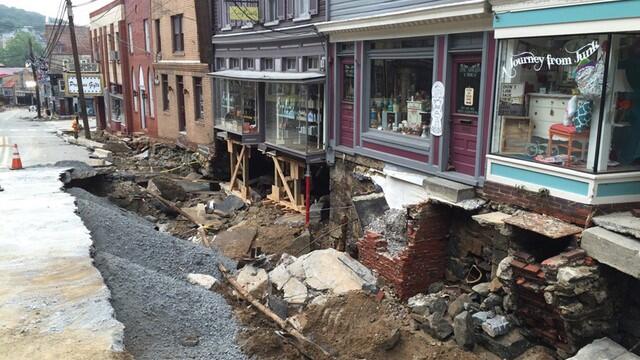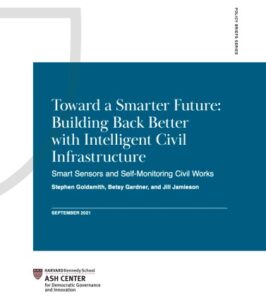In a new paper published by the Ash Center at Harvard University, Professor Stephen Goldsmith and his co-authors Betsy Gardner and Jill Jamieson argue that intelligent infrastructure should be a priority for both policymakers in Washington and state and local governments officials developing infrastructure spending plans.
In Toward a Smarter Future: Building Back Better with Intelligent Civil Infrastructure — Smart Sensors and Self-Monitoring Civil Works, Goldsmith, Gardner, and Jamieson illustrate how smart infrastructure plans that integrate digital technology, sensors, and data can help bridge the country’s infrastructure deficit by mitigating risks and improving the conditions and structures that shape our daily lives.
To enable local government to quickly identify issues with infrastructure before they become acute dangers, the authors make the case for incorporating data analysis with intelligent infrastructure, which integrates digital technology and smart sensors in order to monitor the country’s roadways, buildings, and bridges.
Goldsmith, Gardner, and Jamieson cite the example of sensor systems and other intelligent technology that can identify and mitigate many of the public safety threats posed by deteriorating infrastructure caused by climate change.
They also argue that better utilizing intelligent infrastructure is critical for addressing past and future infrastructure inequities.
For policymakers, the paper urges leaders at all levels of government to consider the transformative potential of intelligent infrastructure:
- Federal officials, they advise, should look beyond roads and bridges and consider intelligent infrastructure as a system: upheld, connected, and integrated by data;
- At the state level, budgeting with intelligent infrastructure in mind will encourage innovative approaches to local infrastructure; and
- On a municipal level, cities and towns can invest in comprehensive asset management systems and training for local workers to best utilize the intelligent infrastructure data.
ABSTRACT:
The United States needs to build better infrastructure. The current repairs and replacements are disorganized and patchwork, resulting in unsafe, costly, and inequitable roads, bridges, dams, sidewalks, and water systems. A strategic, smart infrastructure plan that integrates digital technology, sensors, and data not only addresses these issues but can mitigate risks and even improve the conditions and structures that shape our daily lives.
By applying data analysis to intelligent infrastructure, which integrates digital technology and smart sensors, we can identify issues with the country’s roadways, buildings, and bridges before they become acute dangers. First, by identifying infrastructure weaknesses, smart infrastructure systems can address decades of deferred maintenance, a practice that has left many structures in perilous conditions. Sensors in pavement, bridges, vehicles, and sewer systems can target where these problems exist, allowing governments to allocate funding toward the neediest projects.
From there, these sensors and other smart technologies will alert leaders to changes or issues before they pose a danger—and often before a human inspector can even see them. The many infrastructure emergencies in the U.S. cost thousands of lives and billions of dollars each year, so identifying and fixing these issues is a pressing security issue. Further, as the changing climate leads to more extreme weather and natural disasters, the safety and resiliency of the country’s infrastructure is an immediate concern. Sensor systems and other intelligent infrastructure technology can identify and mitigate these problems, saving money and lives.
In addition, intelligent infrastructure can be layered onto existing infrastructure to address public health concerns, like monitoring sewer water for COVID-19 and other pathogens or installing smart sensors along dangerous interstates to automatically lower speed limits and reduce accidents. It can also be used to improve materials, like concrete, to reduce the carbon footprint of a project, ultimately contributing to better health and environmental outcomes.
Finally, addressing inequities is a major reason to utilize intelligent infrastructure. Research shows that people of color in the U.S. are exposed to more pollutants, toxic chemicals, and physical danger through excess car emissions, aging water pipes, and poor road conditions. The implementation and funding of these intelligent infrastructure projects must consider where—and to whom—harm has traditionally been done and how building back better can measurably improve the quality of life in marginalized and vulnerable communities.
While there are challenges to implementing a sweeping intelligent infrastructure plan, including upfront costs and security concerns, all levels of government play a role in achieving a safer society. At the federal level, with infrastructure funding bills being debated at this moment, the government must look beyond roads and bridges and consider that intelligent infrastructure is a : upheld, connected, and integrated by data.
Through grants, incentives, and authorized funding, the federal government can effect monumental change that will improve how all residents experience their daily lives. At the state level, budgeting with intelligent infrastructure in mind will encourage innovative approaches to local infrastructure. And on a municipal level, cities and towns can invest in comprehensive asset management systems and training for local workers to best utilize the intelligent infrastructure data.
Photo of flood damage in Ellicott City, Maryland in 2016 courtesy of FEMA.


